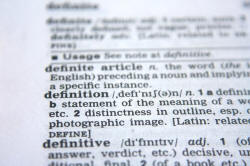Adjacency pairs

We'll start with a simple example of an exchange containing two adjacency pairs. For ease, we'll show them in different colours, with pair 1 in red and pair 2 in black, like this:
| Speaker | Utterance | Description |
| George | Hello, Peter. How are you? | Formulaic greeting |
| Peter | Oh, hi. Fine, thanks | Formulaic greeting response |
| George | Has Mary got in yet? | Request for information |
| Peter | I think so. | Preferred provision of information |
In that little exchange we have two pairs as you can see and they
form an orderly queue so that the conversation, such as it is,
remains coherent. If Peter's first and second responses are
swapped around, the conversation would become immediately bizarre
and impenetrable.
Adjacency pair 1: greeting – greeting response
Adjacency pair 2: ask for information -–supply information
The note that Peter's second response is preferred
signals that there is another alternative which is dispreferred and
that might be:
I don't
know
which changes the second pairing to:
ask for information–profess ignorance
and that is not usually what the questioner wants.
It is not claimed here (or by anyone who knows a little about language) that all conversations develop via the use of predictable adjacency pairings but it is certainly true that a good deal of conversation between people would not be possible unless they form substantial parts of the exchanges.
 |
Defining characteristics |
Adjacency pairs are a concept within conversational analysis and
particularly in the study of turn taking.
Pragmatically, adjacency pairs are characterised by four related
phenomena:
- adjacent
That is to say they follow each other directly in conversational exchanges. - produced by different speakers
so are part of how turns are exchanged, held and interrupted. When speakers have produced the first item in a pair, they usually fall silent and wait for the second part to appear in the exchange. - ordered
in that it is usually (not always) possible to detect which of the pair precedes the other, i.e., which is the first and which the second part of an exchange. - typed
so the first part requires (or usually evinces) a particular sort of second part rather than it being a randomly generated utterance.
All of the above was elucidated a while ago by Schegloff and Sacks (1973).
 |
Examples of adjacency pairs |
No list of all the possible adjacency pairs in any language is
possible. They are, however, quite easy to identify if not to
list exhaustively and any extended exchange between speakers will
normally contain multiple examples. Here's a short list with
some examples. Do not try to teach them all at once.
Preferred responses are in green,
temporisations in yellow and
wholly dispreferred responses in pink
(although, of course, there are degrees of preferment).
| Pairing | Examples (preferred and dispreferred) |
| accusing → apologising | You took it without asking → I’m sorry, you weren’t here |
| accusing → denying | You have broken it → No, it wasn’t me |
| accusing → temporising | You took it without asking → Took what? |
| advising → accepting advice | You should take a break → Yes, I think I will |
| advising → rejecting advice | You need to eat more → I am happy as I am |
| advising → temporising | You should take a break → Maybe later |
| apologising → accepting apology | Sorry I’m late → That’s OK |
| apologising → rejecting apology | Sorry I’m late → It's not good enough |
| apologising → contingent acceptance | Sorry I’m late → OK, but make sure it doesn't happen again |
| asking for clarification → supplying clarification | When exactly did you say? → Early tomorrow morning |
| asking for information → supplying information | What day is it? → Thursday |
| asking for information → professing ignorance | When does the train leave? → I don’t know |
| asking for information → temporising | What will it cost? → I’ll find out for you |
| asking about ability → expressing ability | Are you able to help? → Sure |
| asking about ability → expressing inability | Can you lift it? → Not with my back |
| asking about ability → temporising | Are you able to help? → Not right now. Is it urgent? |
| asking for help → offering help | Can you help me? → Sure. What can I do? |
| asking for help → refusing to help | Can you help me? → Nope. Sorry. |
| asking for help → temporising | Can you help me? → Not right now. Can it wait? |
| asking for permission → giving permission | Can I go now? → Yes, that’s fine |
| asking for permission → refusing permission | May I ask a question? → Please wait till the end |
| asking for permission → temporising | Can I bring a friend? → You'll have to ask Mary |
| asking for speculation → providing speculation | Do you think it’ll rain? → No, I doubt it |
| asking for speculation → refusing to speculate | Do you think Mary will like it? → How should I know? |
| beckoning → responding | Excuse me! → Yes, madam |
| complaining → excusing oneself | You’re very late → I know the traffic was awful |
| complaining → remedying | It’s cold in my room → I’ll turn up the heating |
| complaining → rejecting complaint | It’s not working → Well, that's your fault, isn't it? |
| complaining → temporising | It’s not working → We'll get it fixed when we can |
| complimenting → accepting | I really like that shirt! → Oh, thanks |
| complimenting → deflecting | That was really well done! → It wasn't me that did it |
| encouraging → accepting encouragement | Come on, try again → Alright |
| encouraging → rejecting encouragement | Come on, try again → No, it's just too difficult |
| expressing hope → concurring | I hope it’ll be sunny → So do I |
| expressing hope → being pessimistic | I hope it’ll be sunny → I doubt it will be |
| expressing satisfaction → acknowledging | That’s great, thanks → Glad you are pleased |
| expressing satisfaction → temporising | That’s great, thanks → It won't last long |
| expressing unhappiness → acknowledging | I don’t feel happy here → Oh, dear. What can I do? |
| expressing unhappiness → advising | I don’t feel happy here → Then go home |
| greeting → greeting response | Hi! → Oh, hi! |
| identifying → acknowledging | That’s her brother → Oh, is it now? |
| identifying → correcting | That’s her brother → No, it isn't. It's Jane's uncle |
| informing → acknowledging | Your mother is here → Thanks |
| informing → correcting | Your job is to get it right → No, that's her job |
| introducing oneself → responding | Hi, I’m Mary → Pleased to meet you. I'm Jack |
| inviting → accepting | Come for lunch → OK, what day? |
| inviting → declining | Would you like to stay for dinner? → I can’t – sorry |
| inviting → temporising | Would you like to go out? → Maybe later, if that's OK |
| leave taking → leave taking response | See you! → Yeah, bye |
| obliging → accepting obligation | That needs to be done now → I’ll get on to it |
| obliging → rejecting obligation | That needs to be done now → Not by me, it doesn't |
| obliging → temporising | That needs to be done now → Can't it wait? |
| offering → accepting | Would you like a drink → Yes, thanks, I'll have ... |
| offering → declining | Can I get you anything else → No thanks |
| offering → temporising | Can I get you anything else, sir? → Maybe later |
| offering help → accepting help | Can I help you? → Yes, please |
| offering help → declining help | Can I help you? → I’m just looking, thanks |
| offering help → temporising | Can I help you? → I'll call if I need it |
| reminding → acknowledging | Don’t forget the wine → I won’t |
| reminding → asking for information | Don’t forget the wine → What wine? |
| requesting → accepting | Is it OK if I borrow this? → Sure, help yourself |
| requesting → rejecting | Is it OK if I borrow this? → I'd rather you didn't, I need it |
| requesting → temporising | Is it OK if I take this? → Not right now. You can have it later |
| seeking agreement → agreeing | Isn’t that beautiful? → Yes, lovely |
| seeking agreement → disagreeing | Isn't this wonderful? → Not to me |
| stating → agreeing | It’s going to be a long journey → Yes, I'm afraid it is |
| stating → disagreeing | It’s going to be a long journey → No, not really |
| suggesting → complying | Shall we go? → Yes, let’s |
| suggesting → refusing | Shall we go? → No, I want to stay |
| suggesting → temporising | Shall we go? → Let's stay a little longer |
| thanking → acknowledging | That’s kind of you → No problem |
| warning → acknowledging | The plates are very hot → Thanks, I’ll be careful |
This list could be extended by subdividing some of the functions
and reduced by combining them.
The left-hand items in that list are, of course, recognisable
language functions and their realisation may be achieved in a wide
variety of ways. For example, an offer of reassuring advice
not to worry could be couched as:
You shouldn't worry too much
Oh, do stop worrying
You don't need to worry
Worrying won't help, you know
and so on and you can probably think of lots of ways all the other
functions in the list can be realised.
If you would like that list as a PDF document,
click here.
Long lists like this are perhaps helpful for planning purposes because they can remind us of the areas to cover and give us a way of structuring speaking skills lessons. They can, however, be quite severely condensed into three main sorts (which, to some extent, overlap. Like this:
- The descriptive function
Giving and understanding factual information. For example:
Can you tell me where the station is?
It's getting late
I'm taking the train home
I can't help you
etc. - The expressive function
Relaying and understanding of information about the speaker's feelings, preferences and ideas. For example:
I'm not feeling well
I really don't like that man
I am not even going to try
etc. - The social function
Establishing and maintaining social relationships, especially roles and power structures. For example:
Can I help you, madam?
Anything else?
Good morning officer. How can I help you?
etc.
It is important, especially at more advanced levels, to get away
from the preferred responses and equip our learners with the
language resources they need to supply dispreferred responses, too,
and to be able to respond to them (see below for follow-up moves).
Dispreferred responses also tend, as we see above, to be more
complex because speakers are aware that they are not the responses
the first speaker wanted and are usually concerned therefore, to
give an explanation or add some kind of softening apology.
Without that, dispreferred responses can be seen as discourteous,
even aggressive.
 |
Triplets |
It has been consistently shown in studies of conversation that
pairs of utterances are not the end of the story.
In many cases, conversational exchanges consist of three, not two,
moves. Here are some examples of what is meant:
- evaluation of the exchange
- This may occur as the third part of the triplet so we get,
for example:
How long can you stay?
Well, I don't need to get back till Thursday
Great, then we'll have some time together - reaction to the exchange
- This occurs when the third part involves some kind of action
on the part of one of the speaker, like this, for example:
What time are you meeting John?
Not till seven
Then I can come, too - signalling comprehension
- This occurs as a follow-up move and often signals the end of
the conversation altogether, like this:
Is Mary in her office?
No, she's still at the meeting
OK. Thanks - signalling a topic change
- This is often the response to a temporising expression such
as in:
Can you help me with this?
Not right now. I need to go out
OK, I'll ask John
Because the third part of a triplet is often signalled non-linguistically, by gesture, or action, it is often missed altogether but many exchanges do transpire in three parts and it's helpful to plan for that in the classroom.
 |
The structure of adjacency pairs: IRF sequences |
Whatever its function, the first part of any adjacency pairs
constitutes an initiation in conversation and the second part
constitutes a Response. The third part of a triplet, when it
exists, usually constitutes a Follow-up move but may also contain a
new Initiation.
The structure, therefore is:
Initiation → Response → Follow up → New initiation → Response etc.
The following is based on Tsui (1994):
- Initiation
There are four ways to start a conversation:- Elicit (ask if). E.g., Have you eaten?
- Request (ask to). E.g., Can I ask you something?
- Direct (tell to). E.g., Pay attention to this; it's important.
- Inform (tell that). E.g., I noticed you didn't come to the meeting.
- Response
There are three types of response to an initiation. For example to the Initiation, Can you do me a favour? we can have:- Positive (preferred): Yes, sure, what can I do?
- Negative (dispreferred): Sorry, I need to go now.
- Temporising (dispreferred): Maybe. Will it take long?
- Follow up
There are also three sorts. Following from the three responses above, we can have:- Endorsement (positive). Great.
- Concession (negative outcome). Oh, I see.
- Acknowledgement (negative outcome). It's OK, I'll get John to help.
Whatever the form, therefore, the first part of a pair will take
perform one of the four possible types set out here. For
example:
Those clouds are getting darker
is clearly an informing move (1.d., above) but may serve to function
as a request for speculation meaning, e.g.,
Do you think it'll rain?
a suggestion meaning:
Let's get under cover
and so on.
Equally, something like:
Can you spare me five minutes?
is clearly a requesting move but can also serve a number of
functions such as:
I need some help
I want to talk to you
I have a request to make
and so on.
The second part of the pair constitutes the Response move and, as
we see above, it can come in three sorts: positive, negative and
temporising. Again, the form will vary but the function
remains consistent so we get, e.g.:
I'm busy right now
which is an informing move but serves as a negative response or
Can it wait a little?
which is an elicitation but serves to temporise and
Tell me how
is a directing move but serves as a positive response.
The third part of a triplet will generally be a Follow-up move
and, again, we can analyse them as we did here or take the four-part
analysis we used in the last section. We can get, therefore:
Oh, good. Thanks
which is an evaluation and endorsement
Oh, OK, then
which is concession to a negative response signalling comprehension
Ah, I see. No problem. I'll try
later.
which is an acknowledgement of a negative response signalling the
speakers reaction to it.
This may all seem a rather fine analysis but it has important teaching and learning benefits because it allows us to break down one of the most difficult skills to acquire, speaking, into manageable, learnable and memorable chunks.
 |
The value of adjacency pairs |
Presenting language in the context of adjacency pairs has some obvious advantages:
- It allows for simulated authentic practice because it has been shown that adjacency pairings are drivers of real conversation.
- It accustoms learners to initiating as well as responding in conversations.
- It sets language structures in familiar and recognisable contexts.
- It is a flexible and repeatable with different realisations of the functions.
- It provides realistic practice of communicative events that learners may well encounter outside the classroom.
 |
Teaching: traps and pitfalls |
Used well, adjacency pairs can be very useful ways to present and practise language as the list above shows but there are hazards to avoid.
- leaving out the follow up

- A common use for adjacency pairs is, of course, to encourage
learners to recognise the function of the language they hear and
then respond appropriately. As we saw, one of the defining
characteristics of adjacency pairs is that they are typed and
that means that only a narrow range of second-part responses are
likely to be acceptable or appropriate. So, for example:
Do you know what time the train leaves for Brighton?
is unlikely to be followed by anything except:
Yes, at ...
No, sorry.
No, but I'll check for you
In the first case, we have the preferred response, in the second a dispreferred negative response and in the third a partially dispreferred temporising response.
However, in reality, as we saw above, triplets are a common extension of adjacency pairs so a more realistic set of three exchanges might be:
Do you know what time the train leaves for Brighton?
Yes, at ...
Fine thanks.
Do you know what time the train leaves for Brighton?
No, sorry.
Oh, I see
Do you know what time the train leaves for Brighton?
No, but I'll check for you
Thanks that'd be helpful
Failing to alert learners for the need for a follow up, be it evaluative or any of the other types listed above ill equips them for real-life encounters and may lead to them sounding curt, discourteous, plain rude or even aggressive.
It's easy to avoid that. - depending on separate utterances

- One obvious advantage of using adjacency pairs and triplets
is that it allows you to clearly to indicate what is happening
when each person speaks and allows the learners, too, to notice
how conversations in English are structured.
We can, then set up a scene and get the learners to identify the functions of the language people are using, like this:
Peter: Are you very busy?
John: No, tell me how I can help
in which we have a request for help masquerading as a question about fact and an offer masquerading as an imperative.
Helping learners to recognise the function the language is realising, regardless of it form is a very useful thing to do, of course but it can lead to too much analysis and not enough synthesis. What we can end up with is something like:
Mary: Where did you get that laptop?
Jane: From a company in London
Mary: Thanks
which looks like a simple and realistic exchange but is actually a parody of how people really talk to each other. It can be analysed as:
Initiation: asking for information
Response: providing information
Follow-up: signalling comprehension
but such an analysis is misleading.
A much more realistic exchange is more complex but can still be analysed successfully in adjacency pairs like this:
You can readily see that there are only five turns in the exchange (two from Jane and three from Mary) but there are eight functions being realised. The reason for this is that responses are often combined with initiations as we see with Jane's first turn and Mary's final turn.Speaker Utterance Function Mary Can I ask you something? Initiation of a request Jane Sure Preferred response to a request What do you need to know? Initiating an offer of information Mary Where did you get that laptop? Initiating asking for information Jane From a company in London Responding by providing information Why do you ask? New initiation of a request for information Mary I need to replace my old thing. Responding with information Are you happy with it? New initiation asking for an indication of satisfaction
Teaching solely in isolated adjacency pairs can lead to learners being unable to initiate conventionally after a response move. What that means in the real world is that conversations grind to a halt very quickly and no maintenance of the exchange is possible.
This also means that learners need to be exposed to and encouraged to notice the fact that in most conversations, the turn which includes part 2 of the first adjacency pair will usually also include part 1 of the next pair.
If now you reexamine the long table of possible adjacency pairs that was presented above, you can easily see that as stand-alone conversations they are inadequate for the purposes of teaching conversational skills but important for the purposes of analysing the ways information moves between people.
We need to do both. - ignoring the dispreferred

- It would be a happy world if all adjacency pairs were
positive experiences in which, for example, all requests were
fulfilled, all information promptly given and all offers
accepted without hesitation.
That is not how life works so we need to prepare our learners to understand and supply the dispreferred responses.
Dispreferred responses are, however, more complex precisely because they are dispreferred.
Compare this:
Can you give me a lift to the station?
Sure. When do you want to go?
in which we have a request for action followed by acceptance and, note, a new request for information, forming part 1 of the next pairing (see above), with this:
Can you give me a lift to the station?
Well, I would, of course, but I have to stay in and wait for this call. I'm sorry about that.
There are some things to notice:- There is no direct refusal to comply. In most Anglophone cultures a direct refusal is avoided when possible unless the power relationships are very clear.
- There is positive temporising with the word would
intended to imply that the matter is not in the speaker's
control. In other words, this forms a conditional
utterance along the lines of:
I would if I could, but I can't - A reason for the dispreferred response is given. This is a ubiquitous phenomenon when a speaker is supplying what is known to be a dispreferred response. It is almost a rule of speaking to explain why a dispreferred response is being given and that applies even when the power relationships are unequal. You may be forbidden entry to a street or venue but the police officer or the doorman will almost always tell you why.
- There is a new initiation at the end which takes the form of an apology and this, too, is almost always present in these cases.
Even a temporised response is more complex than the preferred one. Here's another example:
Can you give me a hand with this?
I can't right now because I have to get this email written but give me half an hour and I'll be right with you.
and in that exchange, although the response is not wholly dispreferred the response is still complex, containing as it does a reason for temporising and the offer of a compromise solution.
That, too, has to be taught. - neglecting cultural considerations

- Adjacency pairs are not universals of human communication.
This is not the place for a short book about how they work
across human cultures but you may be sure that the accepted
patterning we have exemplified in this guide will not apply
universally.
We are focused here on Anglophone cultures and even within them there are quite important differences.
In some cultures, for example, declining an invitation to eat is seen as very rude and in others requesting support from superiors is seen as a failing to be avoided if at all possible.
In others, a compliment may be interpreted as a request for a gift and so on.
Potentially, therefore, if learners are tempted to apply their own cultural standards to adjacency pairs, a good deal of miscommunication and bewilderment can ensue.
To counteract this, it is often necessary to do a little awareness raising and cross-cultural comparison, especially in multi-cultural classrooms.
It is not difficult to devise a questionnaire of this kind:
and so on.Tick the boxes (and explain) and then compare what you have with your colleagues' responses If ... In the English-speaking culture In my culture ... you refuse an invitation, you have to say why ... someone offers to help you, you can't say no ... someone asks for help, it's impossible to refuse ... someone gives you a compliment, you must thank them
You need to adjust these things to match your setting, of course, but it is important.
| Related guides | |
| teaching language skills | this is an overview of what you and your learners need to know when developing or practising skills |
| speaking overview | for a guide which contains a little more about IRF sequences and why they are important |
| teaching speaking | for the essentials-only guide to how we may develop our learners' speaking abilities |
| communicative strategies | for the guide to some of the ways we manage speaking and interactions |
| assessing speaking | for the in-service guide to assessing speaking skills abilities |
| spoken discourse | for a more technical guide to spoken language in the in-service section |
| turn taking | for the guide to an essential speaking skill |
| backchannelling | for a guide to a key speaking skill often related to turn taking |
| responding to suasion | for a guide to a particular form of adjacency pairings in action |
| skills index | for the index to the overviews of the four main language skills |
References:
Schegloff, EA & Sacks, H, 1973, Opening up closings,
Semiotica, 7 (4), 289-327
Tsui, ABM, 1994, English
Conversation, Oxford: Oxford University Press
